DPF2 overexpression correlates with immune infiltration and dismal prognosis in hepatocellular carcinoma
- PMID: 39006087
- PMCID: PMC11242344
- DOI: 10.7150/jca.97437
DPF2 overexpression correlates with immune infiltration and dismal prognosis in hepatocellular carcinoma
Abstract
Background: Double plant homeodomain finger 2 (DPF2), belonging to the d4 family of structural domains, has been associated with various human malignancies. However, its impact on hepatocellular carcinoma (HCC) remains unclear. The objective of this study is to elucidate the role of DPF2 in the diagnosis and prognosis of HCC. Methods: DPF2 gene expression in HCC and adjacent tissues was analyzed using Gene Expression Omnibus (GEO) and The Cancer Genome Atlas (TCGA) databases, validated by immunohistochemical staining of Guangxi specimens and data from the Human Protein Atlas (HPA). Gene Ontology (GO), Kyoto Encyclopedia of Genes and Genome (KEGG), and Gene Set Enrichment Analysis (GSEA) were used to identify DPF2's potential pathways and functions in HCC. DPF2's mutation and methylation statuses were assessed via cBioPortal and MethSurv. The association between DPF2 and immune infiltration was investigated by TIMER. The prognostic value of DPF2 in HCC was established through Kaplan-Meier and Cox regression analyses. Results: DPF2 levels were significantly higher in HCC than normal tissues (p<0.001), correlating with more severe HCC features (p<0.05). Higher DPF2 expression predicted poorer overall survival (OS), disease-specific survival (DSS), and progression-free interval (PFI). DPF2 involvement was noted in critical signaling pathways including the cell cycle and Wnt. It also correlated with T helper cells, Th2 cells, and immune checkpoints like CTLA-4, PD-1, and PD-L1. Conclusion: High DPF2 expression, associated with poor HCC prognosis, may disrupt tumor immune balance and promote immune evasion. DPF2 could potentially be utilized as a biomarker for diagnosing and prognosticating hepatocellular carcinoma.
Keywords: DPF2; hepatocellular carcinoma (HCC); immune infiltration; tumor prognosis.
© The author(s).
Conflict of interest statement
Competing Interests: The authors have declared that no competing interest exists.
Figures
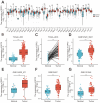




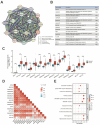

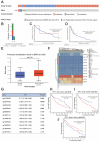
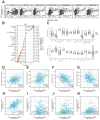
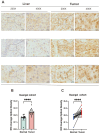
Similar articles
-
Significant correlation between HSPA4 and prognosis and immune regulation in hepatocellular carcinoma.PeerJ. 2021 Oct 26;9:e12315. doi: 10.7717/peerj.12315. eCollection 2021. PeerJ. 2021. PMID: 34754620 Free PMC article.
-
High expression of PDZ-binding kinase is correlated with poor prognosis and immune infiltrates in hepatocellular carcinoma.World J Surg Oncol. 2022 Jan 22;20(1):22. doi: 10.1186/s12957-021-02479-w. World J Surg Oncol. 2022. PMID: 35065633 Free PMC article.
-
AUNIP Expression Is Correlated With Immune Infiltration and Is a Candidate Diagnostic and Prognostic Biomarker for Hepatocellular Carcinoma and Lung Adenocarcinoma.Front Oncol. 2020 Dec 9;10:590006. doi: 10.3389/fonc.2020.590006. eCollection 2020. Front Oncol. 2020. PMID: 33363020 Free PMC article.
-
Expression of tumor-associated macrophages and PD-L1 in patients with hepatocellular carcinoma and construction of a prognostic model.J Cancer Res Clin Oncol. 2023 Sep;149(12):10685-10700. doi: 10.1007/s00432-023-04949-y. Epub 2023 Jun 12. J Cancer Res Clin Oncol. 2023. PMID: 37306737 Free PMC article.
-
Identification of KNOP1 as a prognostic marker in hepatocellular carcinoma.Transl Cancer Res. 2023 Jul 31;12(7):1684-1702. doi: 10.21037/tcr-23-4. Epub 2023 Jun 29. Transl Cancer Res. 2023. PMID: 37588747 Free PMC article.
Cited by
-
G6PC1 expression as a prognostic biomarker associated with metabolic reprogramming and tumor microenvironment in hepatocellular carcinoma.Front Immunol. 2025 Aug 1;16:1623315. doi: 10.3389/fimmu.2025.1623315. eCollection 2025. Front Immunol. 2025. PMID: 40821770 Free PMC article.
-
Role and mechanism of sarcosine dehydrogenase in the progression of gallbladder cancer through chemokine pathways.World J Gastrointest Oncol. 2025 Jun 15;17(6):105016. doi: 10.4251/wjgo.v17.i6.105016. World J Gastrointest Oncol. 2025. PMID: 40547148 Free PMC article.
References
-
- Sung H, Ferlay J, Siegel RL, Laversanne M, Soerjomataram I, Jemal A. et al. Global Cancer Statistics 2020: GLOBOCAN Estimates of Incidence and Mortality Worldwide for 36 Cancers in 185 Countries. CA Cancer J Clin. 2021;71:209–49. - PubMed
-
- Chhikara BS, Parang K. Global Cancer Statistics 2022: the trends projection analysis. Chemical Biology Letters. 2023;10:451. -
-
- Zhang C-H, Cheng Y, Zhang S, Fan J, Gao Q. Changing epidemiology of hepatocellular carcinoma in Asia. Liver Int. 2022;42:2029–41. - PubMed
-
- World Health Organization. GLOBOCAN 2020[EB/OL] 2020-10-01.
LinkOut - more resources
Full Text Sources
Research Materials

